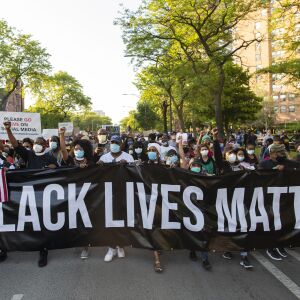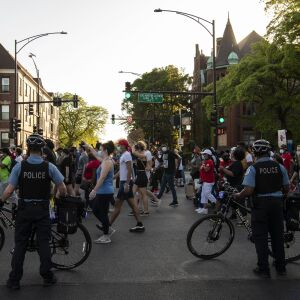For the second straight day, Mayor Lori Lightfoot and Chicago Police Supt. David Brown on Tuesday defended the decisions they have made to protect a city under siege.
From using 375 Illinois National Guard troops — but only to control the downtown perimeter — to steering clear of tear gas to the extraordinary decision to shut down the entire CTA system, Lightfoot defended the difficult decisions she has made to keep Chicago safe.
“None of these decisions are easy. Not one. None of them will be easy for the foreseeable future,” Lightfoot said.
“But the voters elected me to make the right calls, the tough calls and not pander to the crowd, but to do what I felt was best based on the best information and listening to the experts that I have around me and listening to the voices of our residents who are hurting and in need. And that’s what I will continue to do.”
Chicago aldermen continue to second-guess those decisions. They have accused the mayor of being caught flat-footed by violent protests she should have anticipated, then belatedly imposing a curfew and sealing off downtown, which they say pushed looting, arson and mayhem into South and West Side neighborhoods.
Aldermen Brian Hopkins (2nd), Anthony Beale (9th) and Ray Lopez (15th) have argued Chicago needs 3,000 National Guard troops — eight times more than the 375-person contingent Lightfoot requested.
Ald. Pat Dowell (3rd) even took to Facebook over the weekend to ask, “Why do we need over 100 police to enforce a peaceful protest in Old Town when mayhem and lawlessness runs rampant in Bronzeville and Washington Park.”
On Tuesday, Lightfoot and Brown responded to all of the Monday-morning quarterbacks. Their most vociferous opposition was to those demanding an expanded presence and role for the National Guard.
“The National Guard is trained in military tactics. They are not trained in local policing. … We are grateful for the resources the governor provided to us and we are putting them to their highest and best use, which is not patrolling the streets in our neighborhoods,” the mayor said.
Lightfoot is a former Police Board president who co-chaired the Task Force on Police Accountability in the furor that followed the court-ordered release of the Laquan McDonald shooting video. Its scathing report on the Chicago Police Department laid the groundwork for the U.S. Justice Department to do the same and set the stage for the consent decree that is now in place outlining the terms of federal court oversight over CPD.
“There has been a lot of time and effort spent over many years to build authentic relationships between the police and communities that they serve. We are not gonna throw all of that out the window and introduce people who are well-intended, but don’t know about policing at the local level,” the mayor said.
“Their instincts and their training — that muscle memory — is different than ours. They don’t know about the use of force and the level of restraint that we teach our officers.”
Lightfoot has “watched with great horror and caution” when National Guard troops are “embedded with local police” elsewhere.
“The results [are] injuries and even death. We don’t need to bring that in our city.”
Brown added: “What is likely the outcome when rocks are thrown at National Guard? ... and shots are fired from a crowd at the National Guard? Likely not the restraint the patience that our officers have utilized. They don’t have the training … or the experience. To ask them to come into our neighborhoods and be faced with those critical, split-second decisions without the training is asking for more of the same. It’s how we got here.”
The former Dallas police chief was equally defiant when asked why tear gas wasn’t used to disperse some of the more violent crowds in addition to pepper spray.
“Tear gas … is highly flammable. They were already starting fires. Why would you add more flammable material to an already incendiary situation? We have to be smart. We can’t add more flammable toxic fuel to an already planned strategy by those that would do us harm to burn up cars, to burn down businesses,” Brown said.
As for Dowell’s complaint about the 100 police officers assigned to the Old Town demonstration, Lightfoot said it came at the tail end of a weekend filled with protests that started peacefully and turned ugly in an instant when the sun went down.
“Given the [sustained effort] … to try to provoke our police officers into a confrontation, we’re not sending our five officers into a crowd of 50 or 100 people. That is a recipe for disaster,” the mayor said.
“I’ve had people question, ‘Why riot gear, mayor?’ Because people were throwing rocks and bottles and bringing weapons to these seemingly peaceful protests. I believe in preparation. And those police officers have a right to go home to their families, just as all of us do.”
The decision to shut down the CTA from 9:30 p.m. on Monday to 6 a.m. on Tuesday was also a difficult one.
But Lightfoot said it was made after an appeal from CTA union leaders who feared for the safety of their members after some of the violent provocateurs threatened bus drivers and attempted to “commandeer” CTA buses.
CTA President Dorval Carter was also concerned about having “enough people to run the system at night and overnight,” the mayor said.
“The first priority has to be making sure that those employees are safe. What would I be if I was ignoring the pleas of employees who were fearful and hearing from the head of the CTA that he was concerned about the ability to safeguard passengers and employees?” Lightfoot said.
“That’s why we took that very serious action. We did not do that lightly. We won’t do it lightly if we need to again. But if those same combustible circumstances align, I’m not gonna hesitate to do what’s necessary to keep the transit system safe.”
The mayor noted that people were “roaming neighborhoods looting, fighting and doing all sorts of criminal activity” while riding around on Divvy bikes.
“So Divvy did a lockdown,” Lightfoot said. “And I’m grateful for it.”















